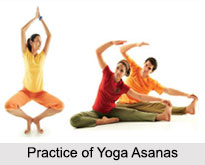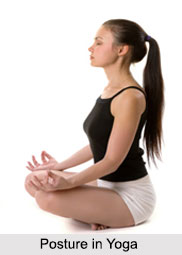 Practice of Yoga Asanas entails several considerations in order to benefit optimally from them. A good course of daily Asanas exercises the joints and major muscle groups, like the spinal and abdominal muscles, improves blood circulation and contributes to steadiness. Asanas must hence be practiced with care and caution. Yoga Asanas are carefully devised to address every practitioner"s requirements and are so arranged that each part of the body receives proper and sufficient exercise. Initially, all movement must be practiced lightly, always stopping short of actual exhaustion. The effect of properly regulated exercise should communicate a sense of optimism and well-being rather than one of exhaustion.
Practice of Yoga Asanas entails several considerations in order to benefit optimally from them. A good course of daily Asanas exercises the joints and major muscle groups, like the spinal and abdominal muscles, improves blood circulation and contributes to steadiness. Asanas must hence be practiced with care and caution. Yoga Asanas are carefully devised to address every practitioner"s requirements and are so arranged that each part of the body receives proper and sufficient exercise. Initially, all movement must be practiced lightly, always stopping short of actual exhaustion. The effect of properly regulated exercise should communicate a sense of optimism and well-being rather than one of exhaustion.
Ideal Age for Practice of Yoga Asanas
 Yoga Asanas are generally non-violent and non-fatiguing in character, and hence are well suited to both the young and the old. Each exercise has a specific positive health value for every age group and has a preventive and a corrective measure for various ailments. Children under the age of 5 should not be initiated into Yoga exercises, since their movements and considered natural as it is. From 5 to 10 years of age, they should practice Asanas that stabilise mental concentration. From the age of 10- 16; youths should be encouraged to follow a daily asana regimen. There is no great risk in following this until middle age (about 40 years), though special considerations begin to apply once one crosses 40.
Yoga Asanas are generally non-violent and non-fatiguing in character, and hence are well suited to both the young and the old. Each exercise has a specific positive health value for every age group and has a preventive and a corrective measure for various ailments. Children under the age of 5 should not be initiated into Yoga exercises, since their movements and considered natural as it is. From 5 to 10 years of age, they should practice Asanas that stabilise mental concentration. From the age of 10- 16; youths should be encouraged to follow a daily asana regimen. There is no great risk in following this until middle age (about 40 years), though special considerations begin to apply once one crosses 40.
Ideal Venue to Practice of Yoga Asanas
One must always practice Yoga Asanas in a quiet and well-ventilated place, which is free from dust and insects. As far as possible, the student needs to be alone because it helps one to keep out all disturbing factors and thus to achieve personal harmony with any particular Asana whether posture exercises, breathing methods or concentration. However those who cannot arrange of such a lonely place, he or she should make the best use of a corner available and practise the exercises in silence.
Ideal Time for Practice of Yoga Asanas
Yoga Asanas are best performed during the morning, before breakfast, as the mind is fresh and the limbs can be moved with a sense of ease and vigour. Most Yogis regard a 15 minute daily dose of vigorous physical exercises as a safe standard for average persons. If the daily dose is missed, the same should be made good as soon as possible at some other time of the day or; at the latest, the next day. It is highly important to maintain a daily regimen. Regularity in training is a fundamental source of success in Yoga Asanas. 
Breathing in Practice of Yoga Asanas
Breathing should be done only through the nostrils for all Asanas, and several Asanas have their own unique breathing patterns, which should be followed scrupulously. When practiced regularly for a sufficient period of time, the mind will automatically meld itself to the body"s motions.
Correct Posture for Practice of Yoga Asanas
A correct body posture will go a long way in keeping the body in shape as well as maintaining a smart, confident appearance. It is advisable to practice in front of a mirror in the early stages, as this will help one observe the accuracy of one"s postures.
Cautions for Practice of Yoga Asanas
Several medical conditions restrict one from the practice of selected Yoga Asanas. People with a heart and lung condition are advised to avoid Sirsasana, Uddiyana, Nauli, Bhastrika and Kapalabhati, as they involve much heavy breathing. Women are also restricted from the practice of Yoga Asanas during their pregnancy period, but can practice during first 3 months of pregnancy.
Intake of proper food and drink is also necessary and forms an important part in the section of technicalities of Asanas. All alcoholic drinks are to be cautiously avoided. Stimulants such as tea and coffee are never to be taken in excess. Yoga Asanas show their maximum effect if the above-mentioned precautions are observed while practicing them.




















